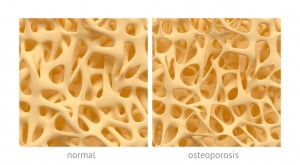Natural Weight Loss - Balance Your Thyroid
Discovering how to balance your thyroid gland hormones can help you lose weight and regain your zest and energy for life.
What is your thyroid gland?
Your thyroid gland is a butterfly shaped gland that wraps around your wind pipe, below your larynx or 'Adam's Apple' at the base of your neck. Your thyroid gland is responsible for maintaining your metabolic rate – the rate at which your body burns calories.
What problems can an underactive thyroid cause?
An underactive thyroid can rob you of your vitality and enjoyment of life. Apart from the weight gain, hormonal disturbances, and exhaustion that accompany an underactive thyroid, there are also more serious consequences.
If you are trying to conceive and have a low thyroid, then you are more likely to be infertile, you will have a four-fold increased risk of miscarriage and a higher likelihood of having a child with impaired IQ. If you are an elderly woman with thyroid problems you will be twice as likely to have blockages in the aorta, and twice as likely to have a heart attack.
Do you have an underactive thyroid?
It is estimated that approximately 40 per cent of the adult population have 'underactive thyroid'or hypothyroid problems - many of these undiagnosed.
Many patients tell their doctor there is something wrong, however the diagnosis of hypothyroidism is often missed. Many people end up frustrated and bewildered. Their doctor says there is nothing wrong, their family thinks they are crazy, yet they know they do not feel well.
While their blood tests may be within normal limits, they may still show obvious signs and symptoms that their thyroid gland isn't operating at its optimal level. These people will almost certainly find it an uphill battle to lose weight, because an underactive thyroid slows metabolic rate.
Do this quick quiz to help find out if an underactive thyroid is contributing to your weight gain and health problems.
Please tick these symptoms if they apply to you:
- Easy weight gain
- Tired and sluggish
- Constipation
- Cold hands and feet
- Tight sensation in neck
- Swelling of the neck
- Difficulty or pain on swallowing
- Brittle nails
- Dry skin
- Puffy face, hands or feet
- Weak muscles that can cramp
- Thinning hair in the outer third of the eyebrows
- Thinning hair
- Pre-menstrual tension
- Excessive menstrual bleeding
- Infertility
- Fluid retention
- Decreased libido
If you don't have these symptoms, that's excellent. You probably do not have an underactive thyroid. If you have more than three of these symptoms, you may be experiencing imbalances caused by an underactive thyroid. Five or more symptoms could indicate a more serious thyroid problem. In this case, you should consider seeing your health practitioner.
Conventional testing for hypothyroidism
If you suspect you have an underactive thyroid, your first step should be to have a chat with a nutrtionally minded doctor or health professional.
They can request some blood or salivary tests to check your levels of thyroid hormones.
These tests should include
TSH or thyroid stimulating hormone. This hormone is secreted by the pituitary gland in the brain. It is elevated if you have an underactive thyroid.
T4 (or thyroxin), a thyroid hormone produced by the thyroid gland
T3 (or triiodothyronine). This is the active form of thyroid hormone which has been converted from T4.
Thyroid antibodies.
If your results come back that your thyroid is underactive, then you need to follow your doctor's prescription. You also need to work out the underlying reasons why your thyroid is not working.
If your results come back "normal" then please be aware that these clinical tests are not that sensitive and can miss many cases of hypothyroidism. I see many patients whose blood tests appear normal but they have the classic thyroid symptoms of weight gain, fatigue, sensitivity to cold, dry skin, hair loss, depression and constipation. Doctors need to be sensitive to the correlation between symptoms and thyroid levels in each individual patient.
The underarm temperature test for hypothyroidism
If your thyroid blood tests appear normal but you have the typical hypothyroid symptoms, I would suggest a more subtle test you can do yourself at home called the "underarm temperature test".
This simple test was developed by an endocrinologist Dr Broda Barnes who realised that the current tests for the diagnosis of hypothyroidism are inaccurate. He proposes that the most sensitive test for picking up most people with low thyroid function is to check the most basic function of the thyroid - the regulation of body temperature.
To test yourself for an underactive thyroid, measure your underarm temperature on waking.
Ensure that you have a legible thermometer, marked in degrees Celsius or an electronic thermometer which beeps when it ready to be read.
Shake the mercury down well the night before use (or use an electric thermometer). Place it in easy reach of your bed.
On waking, place the thermometer under your armpit for at least 5 minutes (or until it beeps). Don't move around or talk before, or while measuring, as this may affect your reading.
If you are a menstruating woman test your temperature on Day 1 to 3 of your next period. This avoids the temperature peak experienced during ovulation. For non menstruating women, or men, test on any 3 consecutive days.
Dr Barnes suggests using the axillary (armpit) temperature rather than the mouth, because so many people have low grade sinus infections which generate heat only in that area, falsely raising the oral temperature.
Try and read your temperature at the same time each day. Note any unusual conditions like ill health, a hangover, less than 4 hours sleep, sleeping in, overseas travel or overheating (avoid using your electric blanket when doing the test). If your temperature is consistently below the range of 36.4 to 36.6 degrees your thyroid is likely to be underactive.
Why conventional treatments are not enough
The conventional treatment for hypothyroidism is the administration of synthetic thyroid hormones. This can restore thyroid function to normal, however be aware that the underlying cause of the problem has not been fixed.
One of the problems with synthetic thyroid hormones is that they often result in excess thyroid hormone in the body, resulting in hyperthyroidism or an overactive thyroid. Symptoms of an overactive thyroid can include palpitations, loss of sleep, nervousness, irritability, heat intolerance, looser or more frequent stools, muscle weakness and exhaustion.
Another problem with the synthetic hormones is that some people don't have enough of the enzyme needed to convert T4 into the active T3 form.
Some doctors prefer to use a natural thyroid hormone extracted from cows. This contains both T3 and T4, however there is some concern that it may be contaminated with harmful viruses.
A recent survey shows that even among patients taking hormone medication, only 60% are within the normal range on thyroid hormone blood tests. The fact that 40% of patients, which translates to millions of people already taking thyroid hormones are still not are within the normal range is of concern.
How to boost an underactive thyroid naturally
If you have an underactive thyroid there is a lot you can do to live a normal, energetic life with natural therapies.
The natural treatment for thyroid problems is based on proper diet, nutritional supplements and gentle body therapies. These remedies are natural, accessible and affordable. However since the large drug companies cannot patent them, most doctors will never prescibe them. These therapies are discussed in my next post "Natural thyroid treatments to help you lose weight".
-
Proven Strategies To Effectively Burn Fat Out Of Your Body Part 1
It is much safer to your long term health to reduce weight by natural
-
Microwaving Kills Food Nutrients? 9 Health Myths Busted
Stop right there: You’re heading out the door into the cold wit
-
Several Dangerous Weight-reduction Plan Mistakes To Avoid At All Cost
Although there is so much info available about weight loss, identical
-
How To Avoid Stress
Dealing with the stress is not an easy thing for a beginner. Yet
-
Secrets To Losing Weight
Many people struggle with losing weight either for a short time in the
-
Simply 100: A Quick Abdominal Blast
Sometimes you just dont even have 10 minutes to work out but y
- DON'T MISS
- New Years Fitness Resolutions Why Do You Break Them Part 3
- Diet Pills The Answer Or Not
- Diet And Exercise Tips
- Tasty Recipes For Cleansing Diet Plans That Assist Thoroughly Clean Your System And Lower Unwanted Weight
- 4 Simple Ways to Stop Food Cravings
- Are weight-loss drugs worth trying?
- What I Tell My Patients About Belly Fat + How To Get Rid Of It
- Why You Should Look At A Ketogenic Diet
- Best Way to Lose Weight in the Summer
- Make Getting In Shape Easier Utilizing This Type Of Advice




